Formula 1 race reports: Japan, Bahrain and Saudi Arabia
While Piastri’s performances in Bahrain and Jeddah show a man on a mission, reigning champ Verstappen, worthy winner in Japan, is still in the thick of it, reports Mark Hughes
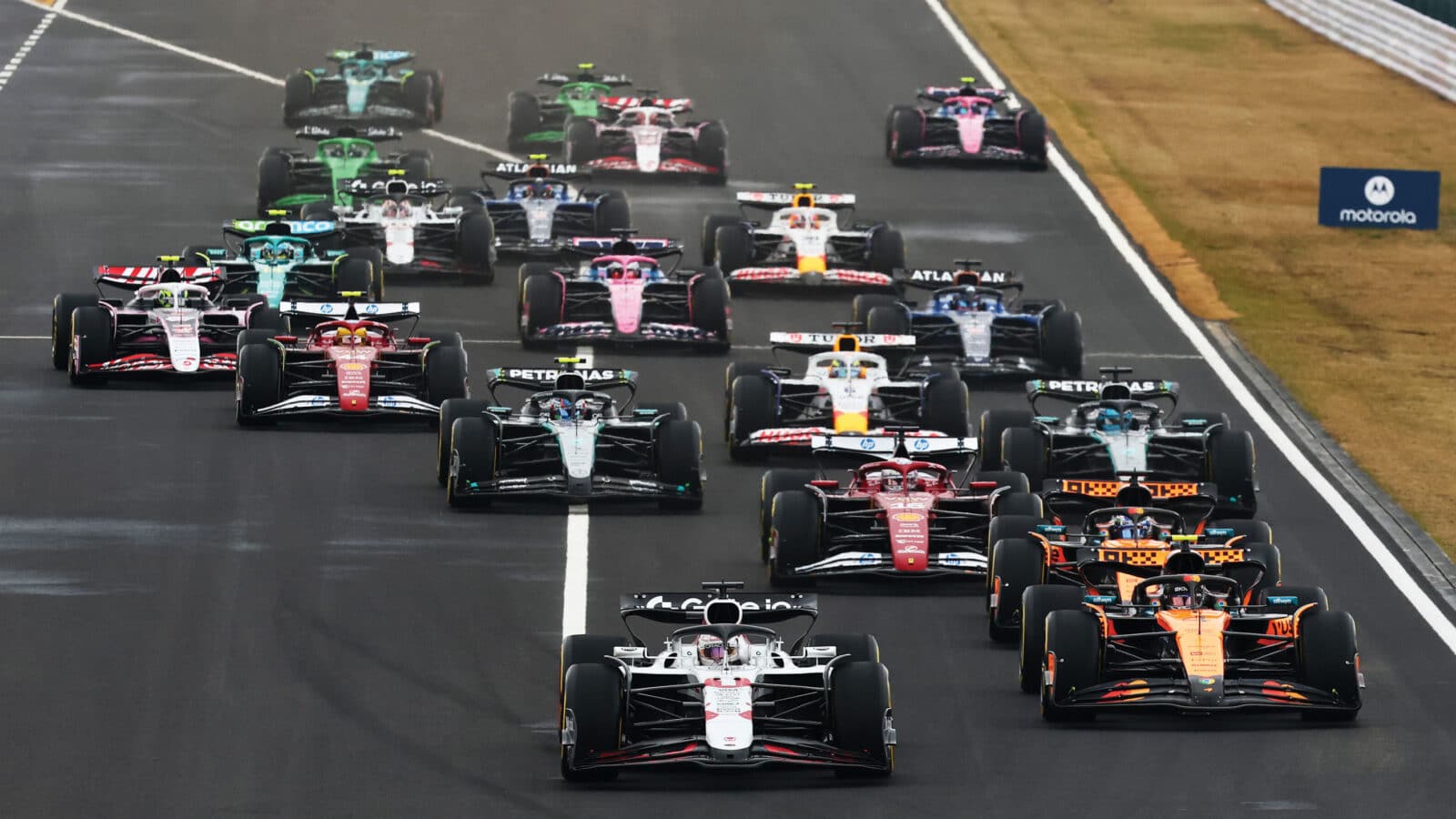
At the Japanese Grand Prix Max Verstappen upset the McLaren stranglehold of 2025 – here leading from pole
Getty Images / Red Bull Content Pool
As the teams have developed their cars going into the final season of these particular ground effect regulations, so a new limitation has become evident. It was first signposted by Red Bull’s competitive fall partway through last season, but has now been confirmed by all the top teams in the early races of ’25: at the even lower ride heights now made feasible by how much more bounce-resistant the cars are, there is a much bigger aero balance shift between the braking and steady state cornering phases. Maintaining through-corner balance at the downforce levels now being achieved has become incredibly difficult.
This is the equation which McLaren has solved better than anyone else, as was very evident in its victories in the opening two races of the season. But it involves compromise. It seems necessary to surrender some performance in slow corners to have the best balance over the full range of corner speeds. Red Bull, in particular, is still struggling with this compromise. It has an RB21 which is generally competitive in high-speed corners and which can be incredibly good under braking and on slow corner entry. But that latter trait is coming from the same big aero balance shift which – when going the other way as the brakes are released into the corner – gives it the mid-corner understeer which often saps away more lap time than gained on entry. The longer the corner, the more lap time this trait costs.
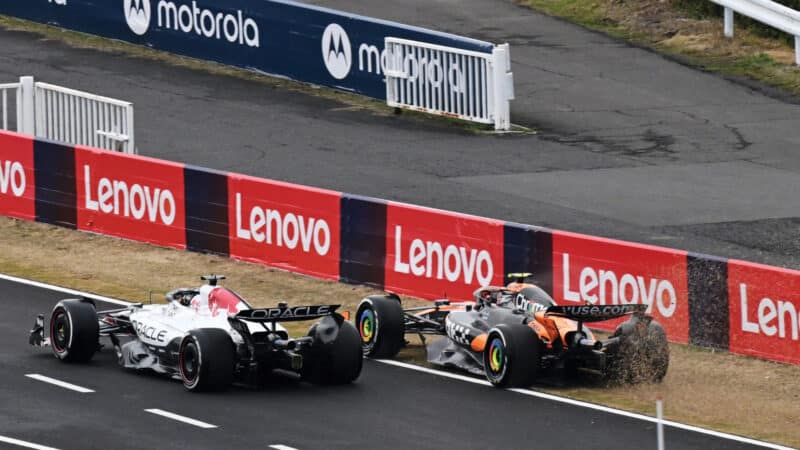
Max vs Lando Norris, Japan
Getty Images
It’s not that Red Bull is unaware of the nature of the problem. It’s just proving hellishly difficult to address, as Christian Horner recounted in Bahrain, the second of three consecutive weekend races, sandwiched between Suzuka and Jeddah. “The problem is that the solutions, with what we see with our tools compared to what we’re seeing on track at the moment, aren’t correlating. That’s what we need to get to the bottom of: why can we not see within our tools what we’re seeing on the circuit? And when you end up with a disconnect like that, you have to obviously unpick it. We’ve got a strong technical team that have produced some amazing cars over the last few years and I’m confident that they’ll get to the bottom of this issue. But it’s literally, the tool isn’t replicating what we’re seeing on the track, and it’s like telling the time on two different watches.
“The tool isn’t replicating what we’re seeing on the track”
“The wind tunnel has driven us in a direction and so then you end up with a mishmash between what your tools are telling you and what the track data is, and so obviously now as we’re accumulating track data, it’s the track data that’s driving the solutions.”
But the difference in Red Bull’s competitiveness between Suzuka – where Max Verstappen won from pole, keeping the two McLarens tight behind him throughout – and Bahrain, where he was a lowly sixth, illustrated how contrasting track layouts impact differently upon the car’s limitations. At Jeddah the Red Bull was once more as competitive as it had been in Suzuka, after suitable set-up changes. The McLarens, meanwhile, seem to be competitive on any type of track. It’s only the margin of superiority which varies.
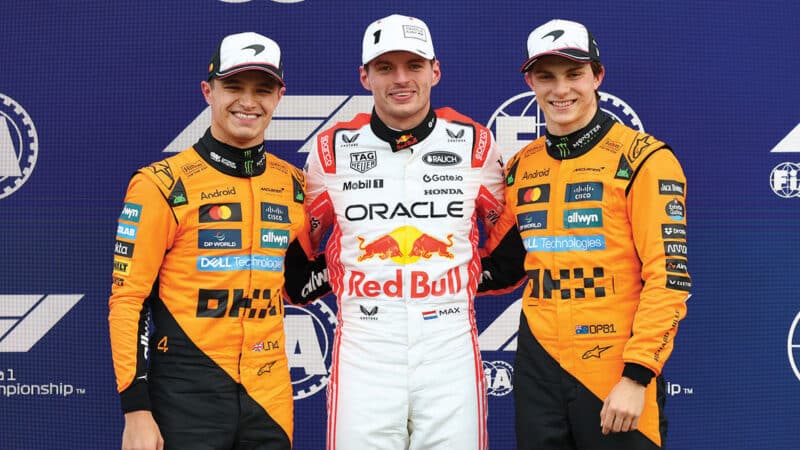
Suzuka podium
Red Bull Content Pool
Ferrari seems to be experiencing much the same problems as Red Bull: a corner entry Lewis Hamilton describes as “super aggressive” followed by mid-corner understeer. Mercedes, having apparently given up on chasing the last problematical bit of downforce after three years and settled instead on consistency, has come up with what appears to be the closest challenger to McLaren, at least in these opening races. That’s the broad lens through which to understand the competitive swings between the three quite different tracks of Suzuka, Sakhir and Jeddah.
“Mercedes has come up with the closest challenger to McLaren”
Oscar Piastri got offline and had a bit of a moment out of Turn 2 on his final qualifying lap of Suzuka. It defined his weekend. His speed on the rest of the lap suggested that the error had cost him pole and he lined up only third. Lando Norris in the sister McLaren was not quite as attuned this weekend, his underlying speed not as great as Piastri’s, but he did at least put his best sector times together and this put him ahead of Piastri on the grid. But both were pipped by Verstappen driving one of the best laps of his career in a Red Bull with a set-up which had been changed extensively through the weekend up to that point.
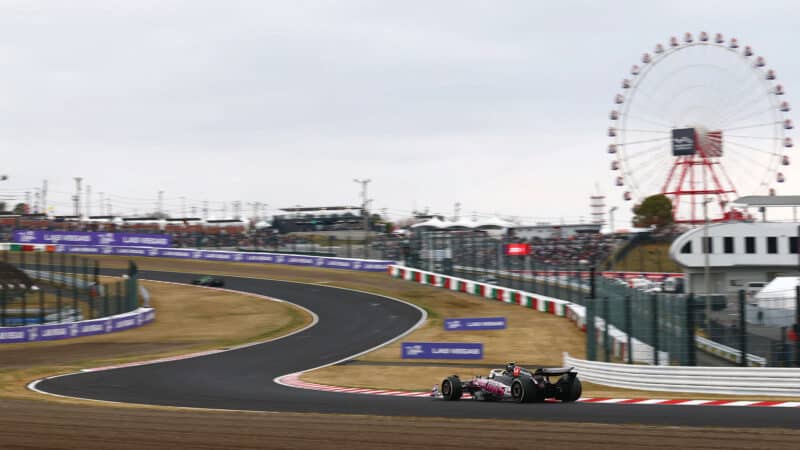
Top 10 finish in the Far East for Oliver Bearman
Getty Images
“We’ve turned the car upside down this weekend,” said Horner “Max has been working hard with his engineering team just trying to get the car in a window and then he’s just gone and delivered the most amazing lap.”
Changes were made to the weight distribution, aero balance, rollbars, springs and, perhaps most notably, wing level. The downforce level was reduced into Saturday. It all enabled him to keep in touch with the faster McLarens through the Esses in sector one before taking time out of them into the slow hairpin. His entry speed into the fast Spoon corner was breathtaking and he admitted afterwards that he wasn’t sure if it was going to stick at that speed. With a slight straightline speed advantage over the McLarens down the following straight he was clawing back his earlier deficit before he then used the car’s superb braking performance to be outrageously late on the left pedal into the chicane. It was the finishing touch which secured him the pole.
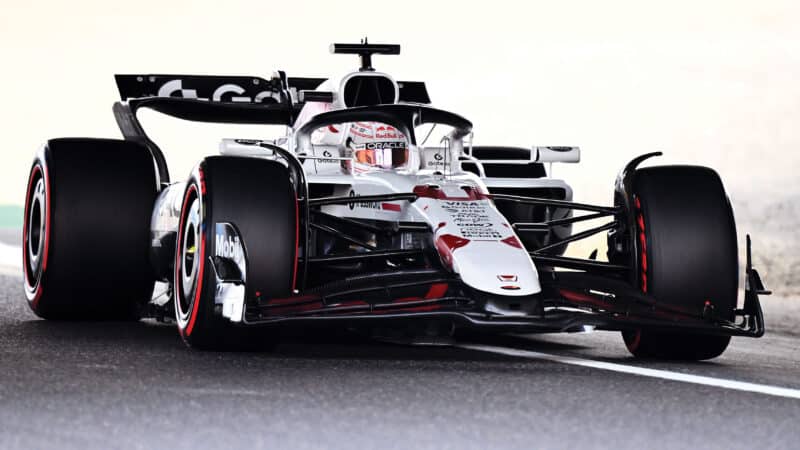
Verstappen edged out the McLarens in qualifying at Suzuka
Red Bull Content Pool
“We are still struggling with the through-corner balance,” he said. “On low fuel and new tyres you can mask it a bit and just send it and see, hope that it sticks.”
That lap was the foundation of an against-the-odds victory. It had been assumed that the better balance of the McLarens would give them a tyre advantage after a few laps. But the resurfaced sector one meant that tyre degradation was remarkably lower than it had ever been around here. So the McLaren advantage wasn’t really rewarded. The lack of passing opportunities around a track where an advantage of over 1sec per lap is needed to make an overtake meant that track position was everything. Hence the finishing order in this one-stop race was pretty much the same as the grid order through the top 10, with Verstappen winning from Norris and Piastri, the trio some way ahead of Charles Leclerc’s Ferrari, which had the two faster Mercedes of George Russell and Kimi Antonelli queued behind him.
A week later the layout of the Sakhir track posed very different challenges to those of Suzuka. It had little effect on the competitiveness of McLaren but impacted heavily upon Red Bull. A bewildering number of set-up changes were again made but this time they couldn’t break the RB21’s Enigma code; on a track very demanding of rear tyre temperatures it was bleeding lap time late on overheated rubber. The only cure for this gave it the general understeer balance with which Verstappen qualified seventh, 0.6sec adrift of Piastri’s pole.
The extent of the Red Bull’s problems allowed both Mercedes, Leclerc and Pierre Gasly’s much-improved Alpine to get between him and the McLarens on the grid. But the papaya cars didn’t monopolise the front row: Norris was openly struggling to match Piastri here and lost out to Russell for P2. Piastri was partly responsible for Norris’s under-par final Q3 lap.
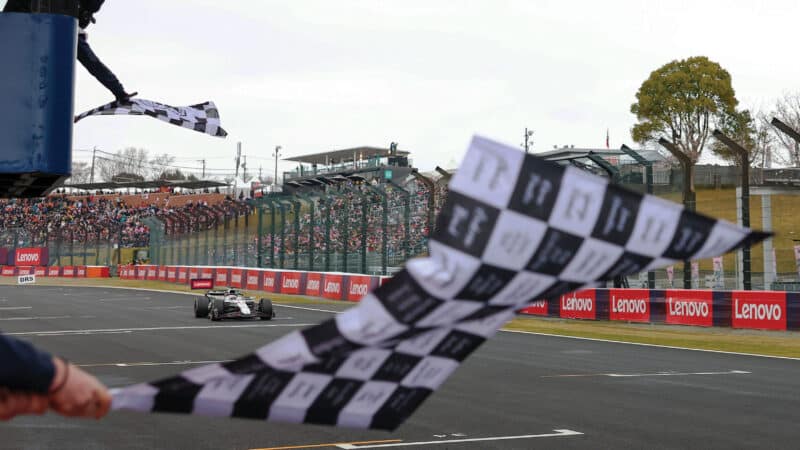
Don’t rule out Verstappen just yet – he left Suzuka just a point behind Norris in the drivers’ standings
Red Bull Content Pool
On race day Piastri gave as perfect a demonstration of dominance as is practical in this era of tyre conservation and safety cars, pulling out around 6-7sec on Russell and just keeping it at that. A safety car 26 laps from the end (to clear off debris from Yuki Tsunoda oversteering his Red Bull’s rear tyre into the sidepod of Carlos Sainz’s Williams) came at an inconvenient time for both Mercedes and Ferrari as they had no suitable tyres for the remaining stint length. Unlike McLaren, they had no new mediums left. The hards (which is all Leclerc had) were too slow, the softs (as chosen for Russell) were marginal on range. Piastri then just drove off into the distance on his fresh mediums, winning by 16sec.
“Sakhir gave very different challenges to those of Suzuka”
Norris meanwhile had been having an eventful time. As he’d tried to manoeuvre his car closer to the line of his grid box, he overshot it, giving him a 5sec penalty to be taken at his stop. He made a great opening few corners to vault from sixth to third but McLaren – in order to maximise his recovery time from the penalty – pitted him early. Which meant that he was on tyres much older than Leclerc later on and the Ferrari was able to pass him. Upon the restart from the safety car he was mugged by Hamilton too. He quickly re-passed that Ferrari but took a long time to find a way back ahead of Leclerc, thus delaying his arrival onto Russell’s tail to just five laps from the end.
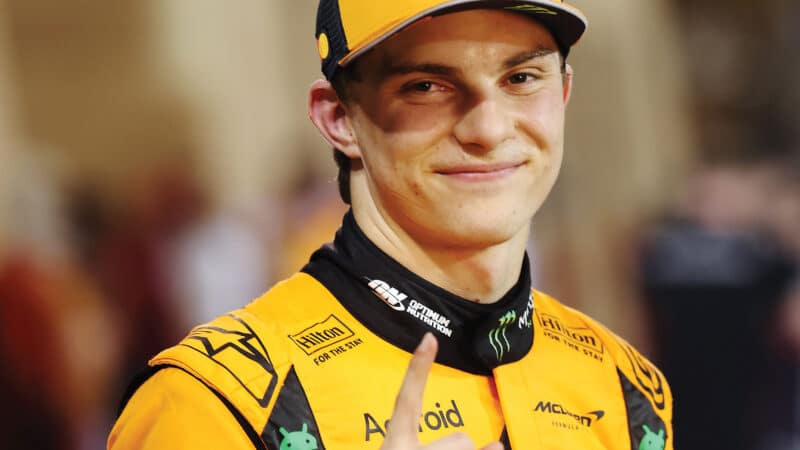
Oscar Piastri, the man of the moment, in Bahrain; we’ll no doubt see this smile a few more times this season
LAT
Russell by this time was coping with a mind-frazzling number of control systems issues in the cockpit. His brake-by-wire had gone into default mode, requiring him to re-arm it after each time he used the brakes. The DRS was not automatically arming either and many of his dashboard functions were dead. He tried radioing the team with what he thought was the back-up radio button but it had been set by the team as the back-up DRS so he inadvertently used DRS outside of the DRS zone for around 1sec, taking care then to back off so as to demonstrate no advantage. All this while trying to get his soft tyres to last and fending off the attacking Norris! It was a remarkable demonstration of unflustered control and the second place he delivered represented one of his career-best drives.
The contrast of Verstappen’s race here and that of a week earlier could hardly have been more stark as he only managed to pass Pierre Gasly’s Alpine for sixth on the last lap.

Piastri leads Charles Leclerc’s Ferrari at the start of the Bahrain GP; he’d also take fastest lap and the win
DPPI
Jeddah moved the challenge more towards that of Suzuka, with its emphasis on high-speed turns of a shorter duration than those of Bahrain. Yet again, the McLarens were straight into the groove; the Red Bull was initially nowhere. There were more re-sets and rethinks at Red Bull between Friday and Saturday as McLaren looked serene, Norris in particular. In Bahrain, he’d admitted he felt all at sea with this car, that the feedback from the front end wasn’t as good as on last year’s car (another of those compromises). But here, through the sixth-gear blasts between the walls, he was driving in a beautiful trance-like flow, the car allowing him to do whatever he liked. Piastri was not quite on the same level here. It seemed the tables had turned again.
“It was a remarkable exercise of unflustered control by Russell”
Then came qualifying. Red Bull had found the car’s sweet spot, just as in Suzuka, and Verstappen was a factor. As the track cooled, so too was Russell’s Mercedes. Norris still looked to have the edge, 0.2sec quicker than anyone in Q1, 0.15sec clear in Q2. Both times he retired to the garage after setting his time and didn’t venture out for second runs, unlike everyone else. That’s how confident he was. Then he crashed. Maybe staying in the garage after setting his fast times in Q1 and Q2 as everyone else made second runs had meant he didn’t have as good a feel for the quick ramping up of track grip. Into his first lap of Q3 he felt how much more grip was available through Turns 1-2 than he had used. Resolving to make amends, he took 7mph more speed into Turn 4 than previously, understeered wide and bounced off the opposite kerb which flicked him into the wall. It was a disastrous error.
Verstappen, meanwhile, in a repeat of Suzuka, delivered a great lap at the perfect time and snatched pole from Piastri by just 0.01sec, with Russell’s Mercedes only a tenth away in third. Without a time on the board Norris would be starting tenth.
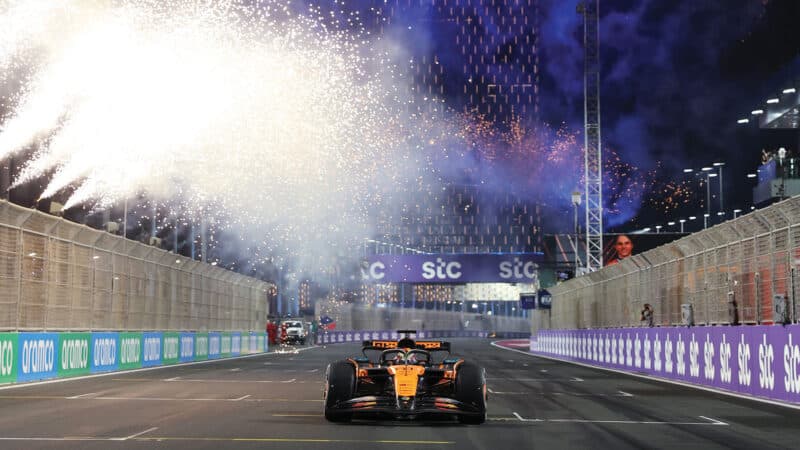
Piastri’s win in Saudi Arabia was his third from five; already there’s talk about a first Aussie drivers’ champion since 1980
Lars Baron/ Steven Tee
Piastri made a great start, Verstappen got too much wheelspin as they raced towards Turn 1 with the McLaren driver claiming the corner. Verstappen refused to concede and took to the Turn 1 run-off, rejoining in the lead. The stewards later awarded him a 5sec penalty, to be taken at his pitstop. He tried to pull out the required gap in the first stint but couldn’t. He rejoined around 3.5sec behind Piastri who was able to maintain that gap to the flag. Leclerc drove a great race, running his Ferrari long in the first stint to get a nine-lap tyre offset to Russell, enabling him to pass the Mercedes for third in the second stint. Norris came through to be challenging Leclerc at the flag but could find no way by.
Piastri, the new leader of the world championship, was taking quiet satisfaction for having made all the right moves.
